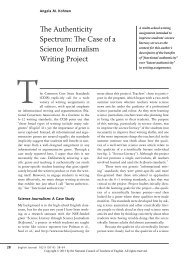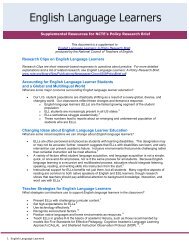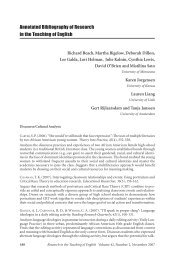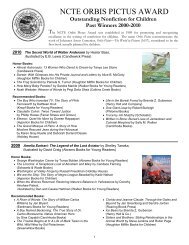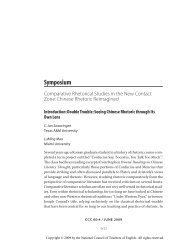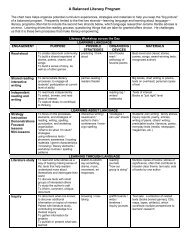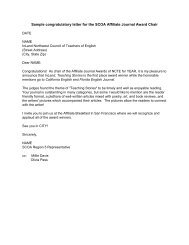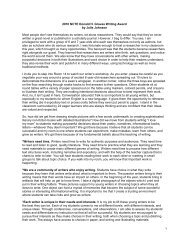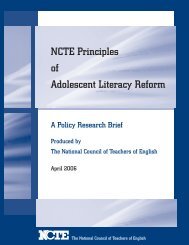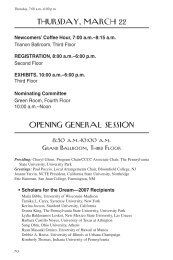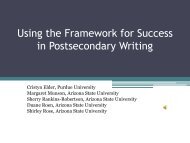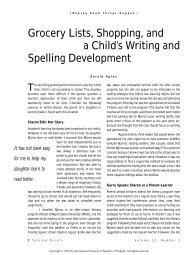Annotated Bibliography of Research in the Teaching of English
Annotated Bibliography of Research in the Teaching of English
Annotated Bibliography of Research in the Teaching of English
- No tags were found...
Create successful ePaper yourself
Turn your PDF publications into a flip-book with our unique Google optimized e-Paper software.
212 <strong>Research</strong> <strong>in</strong> <strong>the</strong> Teach<strong>in</strong>g <strong>of</strong> <strong>English</strong> Volume 41 November 2006Argues that issues surround<strong>in</strong>g adolescent literacies problematize <strong>the</strong> relationship between <strong>the</strong>acquisition <strong>of</strong> core skills, <strong>the</strong> need to connect with a more expansive repertoire <strong>of</strong> literate practices,and a middle-school reform <strong>in</strong>itiative that encourages greater connectedness to <strong>the</strong> world<strong>of</strong> <strong>the</strong> adolescent. Explores <strong>the</strong> concept <strong>of</strong> adolescent literacy through <strong>the</strong> terms public literacyand private literacy via a case study represent<strong>in</strong>g one teacher and one student’s construction <strong>of</strong>literacy <strong>in</strong> an 8th-grade homeroom. Argues that <strong>the</strong> private literacies <strong>of</strong> adolescents need to beteased out and embedded with<strong>in</strong> middle-school reform.HAWKINS, L. S., JOHNSTON, S. S., & MCDONNELL, A. P. (2005). Emerg<strong>in</strong>g literacy views and practices:Results from a national survey <strong>of</strong> Head Start preschool teachers. Topics <strong>in</strong> Early ChildhoodSpecial Education, 25(4), 232-242.Surveys Head Start preschool teachers nationally to f<strong>in</strong>d that teachers employ a range <strong>of</strong> differentstrategies to foster literacy learn<strong>in</strong>g, with a particular focus on pr<strong>in</strong>t awareness and bookunderstand<strong>in</strong>g and less emphasis on phonological awareness. Teachers focus on creat<strong>in</strong>g contextsto foster literacy learn<strong>in</strong>g and support <strong>the</strong> need for daily literacy <strong>in</strong>struction.LILLIS, T., & CURRY, M. J. (2006). Pr<strong>of</strong>essional academic writ<strong>in</strong>g by multil<strong>in</strong>gual scholars: Interactionswith literacy brokers <strong>in</strong> <strong>the</strong> production <strong>of</strong> <strong>English</strong>-medium texts. Written Communication,23(1), 3-35.Exam<strong>in</strong>es <strong>the</strong> <strong>in</strong>fluence <strong>of</strong> “literacy brokers” who mediate and <strong>in</strong>fluence <strong>the</strong> journal publications<strong>of</strong> research from non-<strong>English</strong>-speak<strong>in</strong>g scholars <strong>in</strong>to <strong>English</strong>. Analyzes <strong>the</strong> development<strong>of</strong> three texts to document <strong>the</strong>se literacy brokers’ considerable <strong>in</strong>fluence on <strong>the</strong> construction <strong>of</strong>academic knowledge <strong>in</strong> <strong>the</strong> process <strong>of</strong> translat<strong>in</strong>g and edit<strong>in</strong>g <strong>the</strong> work <strong>of</strong> non-<strong>English</strong>-speak<strong>in</strong>gscholars.LOVE, J. M., KISKER, E. E., & ROSS, C. (2005). The effectiveness <strong>of</strong> Early Head Start for 3-year-oldchildren and <strong>the</strong>ir parents: Lessons for policy and programs. Developmental Psychology, 41(6),885-901.Exam<strong>in</strong>es <strong>the</strong> impact <strong>of</strong> Early Head Start on three-year-olds from 3000 families enrolled <strong>in</strong> 17programs. Compared to control-group children, children <strong>in</strong> <strong>the</strong> program performed better <strong>in</strong>cognitive and language development, displayed higher emotional engagement, and showed loweraggressive behavior. The parents <strong>in</strong> <strong>the</strong> program provided more emotional support and languageactivity, read more frequently, and spanked less than did control parents. The most prom<strong>in</strong>entimpact was found <strong>in</strong> programs that comb<strong>in</strong>ed home-visit<strong>in</strong>g and center-based services.NAGY, W., BERNINGER, V. W., & ABBOTT, R. D. (2006). Contributions <strong>of</strong> morphology beyond phonologyto literacy outcomes <strong>of</strong> upper elementary and middle-school students. Journal <strong>of</strong> EducationalPsychology, 98(1), 134-147.Exam<strong>in</strong>es <strong>the</strong> effects <strong>of</strong> morphological awareness, phonological memory, and phonologicaldecod<strong>in</strong>g on 4th- through 9th-graders’ read<strong>in</strong>g comprehension, read<strong>in</strong>g vocabulary, spell<strong>in</strong>g,and accuracy and rate <strong>of</strong> decod<strong>in</strong>g morphologically complex words. Morphological awarenessmade a significant, unique contribution to read<strong>in</strong>g comprehension, read<strong>in</strong>g vocabulary, andspell<strong>in</strong>g for all grade levels and to all decod<strong>in</strong>g rate measures for 8th and 9th graders. Suggests<strong>the</strong> importance <strong>of</strong> morphological awareness on literacy development.NIPPOLD, M. A., HESKETH, L. J., & DUTHIE, J. K. (2005). Conversational versus expository discourse:A study <strong>of</strong> syntactic development <strong>in</strong> children, adolescents, and adults. Journal <strong>of</strong> Speech,Language, and Hear<strong>in</strong>g <strong>Research</strong>, 48(5), 1048-1064.Tracks syntactic development <strong>of</strong> 120 participants ages 7 to 49 <strong>in</strong> conversational versus expositorydiscourse. F<strong>in</strong>ds greater syntactic complexity <strong>in</strong> expository than conversational discoursefor all age groups, although <strong>the</strong>re were <strong>in</strong>dividual differences across discourses. Growth <strong>in</strong> complexity,particularly <strong>in</strong> mean length <strong>of</strong> T-unit and relative clause production cont<strong>in</strong>ues <strong>in</strong>toearly adulthood and <strong>the</strong>n stabilizes.



